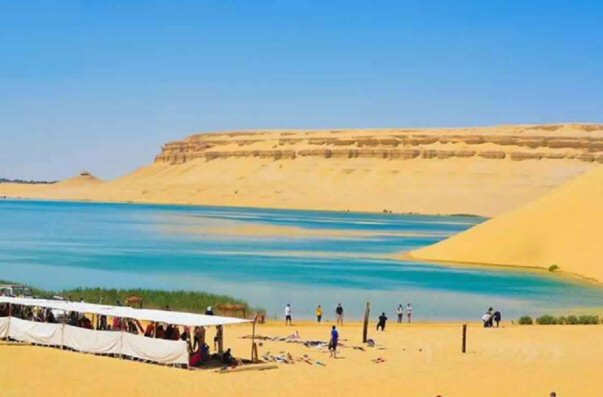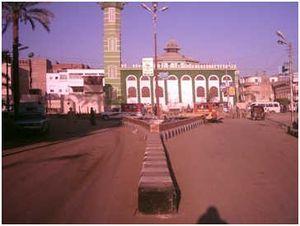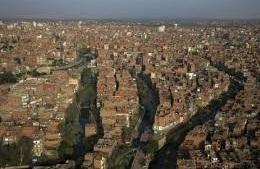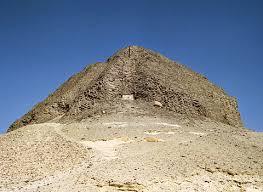El Fayum is one of the governorates in the north-west of Egypt about 100km from Cairo. El Fayum is renowned for its fertile land, fascinating tourist attractions that date back to ancient Egyptian time and its great history. The name of "El Fayum" comes from the Coptic word 'Phiom', which means lake or sea since it was enclosing a sea in the Prehistoric period. Ptolemy II (Philadelophos) gave El Fayoum the name 'Philadelphia'. El Fauoum is also renowned for its Fayimian and Meorian Cultures that date back to the 5500 to 4000 BC. People of these cultures were sedentary and knew methods of agriculture and pottery making. With the climatic changes, around 4000 BC people began to abandon Fayoum and migrate to the Nile Valley, getting in contact with the people of Maadi Culture.


However, El Fayoum remained a savage site for hunting and extracting mining salts. Thus, the Ancient Egyptians identified the lake of El Fayoum with some appropriate names, such as 'the Nun' or the Primeval Ocean, where life began. El Fayoum was the cult of Sobek god, the crocodile, and the lake of El Fayoum was regarded as a sacred place In the Old Kingdom and some temples were established for worshiping him. In the Middle Kingdom the region of El Fayoum witnessed a great prosperity and a large number of temples were established. King Amen-Em-Hat (of the Twelfth Dynasty) chose the site of Lisht, on the midway between the Nile Valley and Fayoum, to be his residence. Amen-Em-Hat I built his pyramid there and it is thought also that he flooded Fayoum to create the Lake Moeris. During this dynasty, the whole region witnessed a wide scale development.
 El Lahun Pyramid, the colossi of Biahmu, the Labyrinth Pyramid all belong to this period. During the Greek Period, the region prospered once again and hundreds of papyri found in different cemeteries of Fayoum provide much information on the booming life the Fayoumians led. But once the region began to decline by the 2nd century, it was gradually abandoned. There are other monuments in El Fayoum including the famous for Karoun Lake and the Valley of Whales, with more than 500 skeletons of whales that are most popular tourist attractions in Egypt. Immersing in a plane view of the scene of the desert, one enjoys seeing a number of valleys, which once were rivers and lakes. In old times, people used to dwell there more than in the Nile Valley. In addition to Lakes, tourist attractions El Fayum has become one of the major agricultural lands in Egypt that is rich in is regarded thanks to the improvement of communicational means, irrigation methods and investment in diverse crops.
El Lahun Pyramid, the colossi of Biahmu, the Labyrinth Pyramid all belong to this period. During the Greek Period, the region prospered once again and hundreds of papyri found in different cemeteries of Fayoum provide much information on the booming life the Fayoumians led. But once the region began to decline by the 2nd century, it was gradually abandoned. There are other monuments in El Fayoum including the famous for Karoun Lake and the Valley of Whales, with more than 500 skeletons of whales that are most popular tourist attractions in Egypt. Immersing in a plane view of the scene of the desert, one enjoys seeing a number of valleys, which once were rivers and lakes. In old times, people used to dwell there more than in the Nile Valley. In addition to Lakes, tourist attractions El Fayum has become one of the major agricultural lands in Egypt that is rich in is regarded thanks to the improvement of communicational means, irrigation methods and investment in diverse crops.
El Fayoum City

El Fayoum is the capital of El Fayoum Governorate in the Western Desert of Egypt, about 130 km southwest of Cairo. The name of Fayum is derived from the Coptic word 'Phiom', which means lake or sea since it was enclosing a sea in the Prehistoric period.
The city is one of the most preferable places not only for foreigners but also for Egyptians for its natural beauty, magnificent weather, and its monuments that date back to several ages throughout history. Thus the main economic resources for the city are local and foreign tourism, administrative services, and trade. On top of the monuments that date back to the ancient Egyptian period come the unique obelisk of rounded top with a cleft of gold statue of Ra. From the Mamluk period, one can find Qaitbay Mosque that is highly admired for its magnificent style of decoration.
Waterwheels that date back to the Greek period is another tourist attraction in El Fayum. Egyptians usually prefer visiting El Fayum Oasis for enjoying the tranquility and good weather away from the noise and crowd of Cairo. Lake Qaroun is the most preferable destination for its crystal clear water and the availability of affordable means of transportations for reaching it.
Youssef El Seddiq City
Youssef El Seddiq is one of the cities of El Fayoum Governorate in the Western Desert . It comprises of a number of smaller towns and villages and the main source of income for the city is agriculture.
Snores City

 Snoras is one of the administrative centers in El Fayoum Governorate that covers about 61970 km. The city occupies a prominent position among other cities in El Fayum for its richness in agricultural products such as wheat, cotton and rice and the prominent Pharaonic monuments that locates in some of its towns and villages. Snors encloses numerous worth visiting monuments that date back to various eras including the Greek, Roman , Coptic , Islamic eras. On top of the Pharaonic Monuments in Snores are the basis of Amen-Em-Hat II statues overlooking Moris Lake. There are also some Coptic tourist attractions such as the remains of Snores Monastery, and Abu Sayfein Monastery with its church of twelve domes that date back to the modern era. In addition to that most of the visitors of El Fayum prefer visiting Ayn El Seleen Gardens which is one of the entertainment centers of all comforts and facilities that allow the visitor enjoying tranquility and peace of mind.
Snoras is one of the administrative centers in El Fayoum Governorate that covers about 61970 km. The city occupies a prominent position among other cities in El Fayum for its richness in agricultural products such as wheat, cotton and rice and the prominent Pharaonic monuments that locates in some of its towns and villages. Snors encloses numerous worth visiting monuments that date back to various eras including the Greek, Roman , Coptic , Islamic eras. On top of the Pharaonic Monuments in Snores are the basis of Amen-Em-Hat II statues overlooking Moris Lake. There are also some Coptic tourist attractions such as the remains of Snores Monastery, and Abu Sayfein Monastery with its church of twelve domes that date back to the modern era. In addition to that most of the visitors of El Fayum prefer visiting Ayn El Seleen Gardens which is one of the entertainment centers of all comforts and facilities that allow the visitor enjoying tranquility and peace of mind.
Qasr Qaroun

 Qasr Qarun is one of the major tourist attractions in El Fayum City that marks the site of the ancient Greek city of Dionysias. It locates the western edge of Qarun Lake in El Fayoum Governorate about 40km from the capital El Fayum. The site had enjoyed great importance during the Greco-Roman Period as here was the beginning of the caravan route to The Western Desert Oasis. The palace is surrounded by some remains of a Roman bath, two temples, a number of fresco-decorated houses, and a fortress.
Qasr Qarun is one of the major tourist attractions in El Fayum City that marks the site of the ancient Greek city of Dionysias. It locates the western edge of Qarun Lake in El Fayoum Governorate about 40km from the capital El Fayum. The site had enjoyed great importance during the Greco-Roman Period as here was the beginning of the caravan route to The Western Desert Oasis. The palace is surrounded by some remains of a Roman bath, two temples, a number of fresco-decorated houses, and a fortress.
Om El Atl
 Om El Atl is a city in El Fayoum Governorate in the Western Desert of Egypt. It is located 8 kn east of the city of Karanis. The main reason behind the importance of the city is the existence of a number of ancient houses and a mud-brick temple dating back to the Greek Period, dedicated to Sobek, the crocodile god.
Om El Atl is a city in El Fayoum Governorate in the Western Desert of Egypt. It is located 8 kn east of the city of Karanis. The main reason behind the importance of the city is the existence of a number of ancient houses and a mud-brick temple dating back to the Greek Period, dedicated to Sobek, the crocodile god.
Madinet Maadi
 Madinet Maadi or ancient Narmouthis is a village that locates 30 km south-west of El Fayoum City in the Western Desert . It is also an archeological site that comprises a Middle Kingdom temple and a Ptolemaic one as well as a Roman town with more than 10 churches. In the area, other minor temples, thousands of papyri in addition to crocodile nurseries with many eggs were discovered.
Madinet Maadi or ancient Narmouthis is a village that locates 30 km south-west of El Fayoum City in the Western Desert . It is also an archeological site that comprises a Middle Kingdom temple and a Ptolemaic one as well as a Roman town with more than 10 churches. In the area, other minor temples, thousands of papyri in addition to crocodile nurseries with many eggs were discovered.
Tamia City
Tamia is an administrative center in El Fayoum Governorate that covers about 6100 km. It comprises of a number of small villages and includes a wide range of agricultural lands. In some of the villages of the city there are some remains of Pharaonic temples and statues including the base of Amen-Em-Hat III Statue and the temple that was dedicated to the worship of Sobek, crocodile god.
Kom Oshim
 Kom Oshim (Kum Ushim) is a town in El Fayoum Governorate in the Western Desert of Egypt, about 130 Kilometers south-west of Cairo. It goes back to the 3rd century BC, when Greek mercenaries founded it. It is an archeological site housing the remains of some Roman baths as well as the remains of the Greek ancient city, Karanis. Moreover, it comprises two temples built to worship variations of the god Sobek (the crocodile god); namely, Petesouchos and Pnepheros.Having the same structure, the Temple of the South is slightly better preserved than the Temple of the North. Both temples comprise the house of the crocodile. The town of Karanis is one of the most frequently visited sites in the Fayoum.The names Karanis and Kom Aushim (Kom Ushim) are often used to denote the same set of ruins in the Fayoum. This Greco-Roman town was founded in the third century BC, probably by Ptolemy II Philadelphus. Accidentally, a number of papyri was found in the archeological site of this ancient city by Egyptian farmers harvesting sibakh left by the site's inhabitants. Excavation at Karanis was undertaken in 1895 by Bernard Pyne Grenfell and Arthur Surridge Hunt. Archeologists believe that the city's inhabitants were poor people from different nationalities.Roman army veterans formed 14 % of the population by 171. Most of the inhabitants were farmers planting wheat, barley, lentils, radishes, dates, figs, peaches, pistachios, walnuts and olives and keeping domestic animals such as dogs, cows, pigs, mules, camels, pigeons and horses as well as antelope and crocodiles.
Kom Oshim (Kum Ushim) is a town in El Fayoum Governorate in the Western Desert of Egypt, about 130 Kilometers south-west of Cairo. It goes back to the 3rd century BC, when Greek mercenaries founded it. It is an archeological site housing the remains of some Roman baths as well as the remains of the Greek ancient city, Karanis. Moreover, it comprises two temples built to worship variations of the god Sobek (the crocodile god); namely, Petesouchos and Pnepheros.Having the same structure, the Temple of the South is slightly better preserved than the Temple of the North. Both temples comprise the house of the crocodile. The town of Karanis is one of the most frequently visited sites in the Fayoum.The names Karanis and Kom Aushim (Kom Ushim) are often used to denote the same set of ruins in the Fayoum. This Greco-Roman town was founded in the third century BC, probably by Ptolemy II Philadelphus. Accidentally, a number of papyri was found in the archeological site of this ancient city by Egyptian farmers harvesting sibakh left by the site's inhabitants. Excavation at Karanis was undertaken in 1895 by Bernard Pyne Grenfell and Arthur Surridge Hunt. Archeologists believe that the city's inhabitants were poor people from different nationalities.Roman army veterans formed 14 % of the population by 171. Most of the inhabitants were farmers planting wheat, barley, lentils, radishes, dates, figs, peaches, pistachios, walnuts and olives and keeping domestic animals such as dogs, cows, pigs, mules, camels, pigeons and horses as well as antelope and crocodiles.
Ebshwai
Ebshwai is one of the centers of El Fayum Governorate that covers about 1230km². It comprises of a number of cities and villages and is renowned for its richness of agricultural products of rice, wheat,and cotton and fruits such as orang and grip. The city is famous for reclamation, raising poultry and many other industries that are regarded as the main source of income for the city and provide youth with job opportunities.
Kom El Hammam
 Kom El Hammam is a Kom El Hammamthat locates about 40km away from El Fayoum City in the Western Desert, south-west of Cairo. It is also an archeological site where the ancient garrison of the town of Philadelphia was established. The village drives its importance from the fact that many mummy-portraits (now scattered among the world museums) were found there.Additionally a great deal of papyri were found there, among which was the archive of Zeno (a Greek steward of Apollonius) in which all the correspondence and registers pertaining to the town's affair were preserved. The site is worth visiting for seeing the attractive ruins of unexplored rock-cut tombs as well as the Seila Step Pyramid.
Kom El Hammam is a Kom El Hammamthat locates about 40km away from El Fayoum City in the Western Desert, south-west of Cairo. It is also an archeological site where the ancient garrison of the town of Philadelphia was established. The village drives its importance from the fact that many mummy-portraits (now scattered among the world museums) were found there.Additionally a great deal of papyri were found there, among which was the archive of Zeno (a Greek steward of Apollonius) in which all the correspondence and registers pertaining to the town's affair were preserved. The site is worth visiting for seeing the attractive ruins of unexplored rock-cut tombs as well as the Seila Step Pyramid.
Atsa City

Atsa is an administrative center in El Fayum Governorate that comprises of some towns and villages. Its main economic resources are driven from agriculture and sugar industries. Atsa is renowned for reclamation, raising poultry and also as a source of limestone and other necessary building materials like sand. Additionally the center encloses a wide range of agricultural lands and is rich in producing wheat, cotton and rice and other important crops.Kasr El Basel is one of the major cities of Atsa Center that encloses El Fayum Sugar factory that provides jobs for a huge number of youth. Of special interest in Atsa is the El Malak Ghabrial Monastery or Deir Abu Khashaba that lies about 16 km away from El Fayum City on El Nakloun Mountaim. This is one of the important Coptic Monuments in Egypt that date back to the 4th century and has a great religious value for Egyptian christians.
El Lahun
El Lahun is a village in El Fayoum Governorate in the Western Desert ,almost 120 kilometers south-west to Cairo. The village's modern name, "El-Lahun", was driven from the ancient Egyptian name 'R3-hnt' which means 'the Mouth of the Lake'.
Among the most important monuments found at this site are the mud-brick Pyramid of Senusert II, a queen's pyramid, some ruins of Senusert Mortuary Temple, and a jubilee chapel. Interestingly, Among the Finds in a small tomb belonging to a princess, Petrie discovered, in 1914, was a treasure of jewelry, cosmetic vessels and other objects, which are now exhibited in the Egyptian Museum and the Metropolitan Museum of New York.


